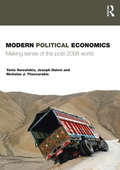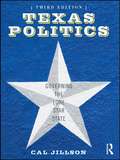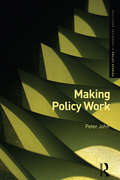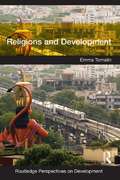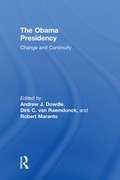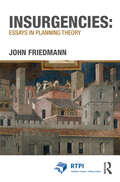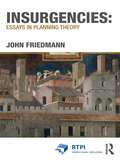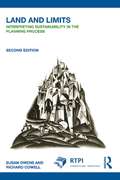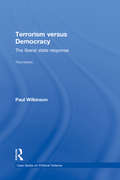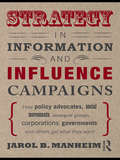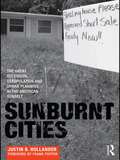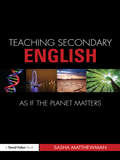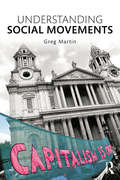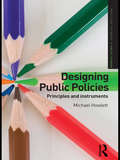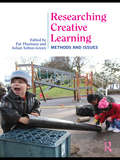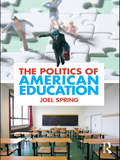- Table View
- List View
Modern Political Economics: Making Sense of the Post-2008 World
by Yanis Varoufakis Joseph Halevi Nicholas TheocarakisOnce in a while the world astonishes itself. Anxious incredulity replaces intellectual torpor and a puzzled public strains its antennae in every possible direction, desperately seeking explanations for the causes and nature of what just hit it. 2008 was such a moment. Not only did the financial system collapse, and send the real economy into a tailspin, but it also revealed the great gulf separating economics from a very real capitalism. Modern Political Economics has a single aim: To help readers make sense of how 2008 came about and what the post-2008 world has in store. The book is divided into two parts. The first part delves into every major economic theory, from Aristotle to the present, with a determination to discover clues of what went wrong in 2008. The main finding is that all economic theory is inherently flawed. Any system of ideas whose purpose is to describe capitalism in mathematical or engineering terms leads to inevitable logical inconsistency; an inherent error that stands between us and a decent grasp of capitalist reality. The only scientific truth about capitalism is its radical indeterminacy, a condition which makes it impossible to use science's tools (e.g. calculus and statistics) to second-guess it. The second part casts an attentive eye on the post-war era; on the breeding ground of the Crash of 2008. It distinguishes between two major post-war phases: The Global Plan (1947-1971) and the Global Minotaur (1971-2008). This dynamic new book delves into every major economic theory and maps out meticulously the trajectory that global capitalism followed from post-war almost centrally planned stability, to designed disintegration in the 1970s, to an intentional magnification of unsustainable imbalances in the 1980s and, finally, to the most spectacular privatisation of money in the 1990s and beyond. Modern Political Economics is essential reading for Economics students and anyone seeking a better understanding of the 2008 economic crash.
Texas Politics: Governing the Lone Star State
by Cal JillsonApproaching the politics of the Lone Star State from historical, developmental, and analytical perspectives, Cal Jillson's text avoids partisanship, ideology, and gimmicks to provide the most comprehensive, readable, and accurate brief description of Texas politics available today. Throughout the book students are encouraged to connect the origins and development of government and politics in Texas—from the Texas Constitution, to party competition, to the role and powers of the Governor—to its current day practice and the alternatives possible through change and reform. This text will allow teachers to share with their students the evolution of Texas politics, where we stand today, and where we are headed. Texas Politics is one of the briefest and most affordable texts on the market, yet it offers instructors and students an unmatched range of pedagogical aids and tools. Each chapter opens with a number of focus questions to orient readers to the learning objectives and concludes with a Chapter Summary, a list of Key Terms, Suggested Readings, and Web Resources. Key Terms are bolded in the text, listed at the end of the chapter, and included in a Glossary at the end of the book. Each chapter presents several photos and numerous tables and figures to highlight the major ideas, issues, individuals, and institutions discussed. Each chapter also contains a Let’s Compare feature, comparing selected states to Texas on various dimensions.
Texas Politics: Governing the Lone Star State
by Cal JillsonApproaching the politics of the Lone Star State from historical, developmental, and analytical perspectives, Cal Jillson's text avoids partisanship, ideology, and gimmicks to provide the most comprehensive, readable, and accurate brief description of Texas politics available today. Throughout the book students are encouraged to connect the origins and development of government and politics in Texas—from the Texas Constitution, to party competition, to the role and powers of the Governor—to its current day practice and the alternatives possible through change and reform. This text will allow teachers to share with their students the evolution of Texas politics, where we stand today, and where we are headed. Texas Politics is one of the briefest and most affordable texts on the market, yet it offers instructors and students an unmatched range of pedagogical aids and tools. Each chapter opens with a number of focus questions to orient readers to the learning objectives and concludes with a Chapter Summary, a list of Key Terms, Suggested Readings, and Web Resources. Key Terms are bolded in the text, listed at the end of the chapter, and included in a Glossary at the end of the book. Each chapter presents several photos and numerous tables and figures to highlight the major ideas, issues, individuals, and institutions discussed. Each chapter also contains a Let’s Compare feature, comparing selected states to Texas on various dimensions.
Making Policy Work
by Peter JohnMany tools are on offer to politicians and other policy-makers when they seek to change policy outcomes. Often they choose to concentrate on one set of tools, but fail to see the costs as well as the benefits – and may not consider the available evidence regarding their effectiveness. This innovative new textbook clearly sets out the main tools of government, and provides an analysis of their efficacy when applied to public problems. Each chapter examines the relative benefits and costs of using a key tool that is available to improve policy outcomes, drawing on a diverse literature, a large number of empirical studies and a range of contexts. Areas covered include: governments and policy outcomes law and regulation public spending and taxation bureaucracy and public management institutions information, persuasion and deliberation networks and governance. Offering a clear and comprehensive evaluation, and highlighting the set of powerful tools commonly available, this text encourages students to consider the most effective combination in order to manage key issues successfully. Including a useful glossary of key terms, this book will be of great interest to all students of public policy, administration and management.
Making Policy Work
by Peter JohnMany tools are on offer to politicians and other policy-makers when they seek to change policy outcomes. Often they choose to concentrate on one set of tools, but fail to see the costs as well as the benefits – and may not consider the available evidence regarding their effectiveness. This innovative new textbook clearly sets out the main tools of government, and provides an analysis of their efficacy when applied to public problems. Each chapter examines the relative benefits and costs of using a key tool that is available to improve policy outcomes, drawing on a diverse literature, a large number of empirical studies and a range of contexts. Areas covered include: governments and policy outcomes law and regulation public spending and taxation bureaucracy and public management institutions information, persuasion and deliberation networks and governance. Offering a clear and comprehensive evaluation, and highlighting the set of powerful tools commonly available, this text encourages students to consider the most effective combination in order to manage key issues successfully. Including a useful glossary of key terms, this book will be of great interest to all students of public policy, administration and management.
Religions and Development
by Emma TomalinReligion has been excluded from development studies for decades. Religious traditions have contributed greatly towards development work, yet major international players have tended to ignore its role. Recent years have shown a noticeable shift in development policy, practice and research to recognize religion as a relevant factor. This text provides a comprehensive insight into different approaches towards the understanding the relationships between religions and development studies, policy and practice. It guides readers through current debates, presenting, explaining and critically evaluating a broad range of literature and locating it within a theoretical context. The text explores the role of religion within development, from positive contributions, such as the important role that many ‘faith-based organizations’ play in education or health care, to more complicated and contested notions of impact, such as religiously inspired violence or gender inequality. The book begins with three background chapters, outlining the relevance of religions for development studies, policy and practice, and introducing the reader to the study of ‘development’ and of ‘religions’. Following these, the focus then shifts to examine a number of thematic areas, including religion, gender and development, and the implications of the ‘rise of religion’ for mainstream development studies, policy and practice in the 21st century. Each chapter contains a range of features to assist undergraduate learning, including learning objectives for each chapter, discussion of key concepts, summaries, discussion questions, further reading and websites. The book also contains over sixty boxed case studies to provide further definition, explanation, and examples of the interactions between religions and development globally. This innovative text presents religions as something that can both obstruct and aid development, encouraging readers to engage critically with the multiple ways that religion impacts on both the conceptualization of development as well the resulting project interventions. This will be of interest to undergraduate, postgraduate students and scholars interested in religious studies, development studies, and the broader study of societies and cultures.
Religions and Development
by Emma TomalinReligion has been excluded from development studies for decades. Religious traditions have contributed greatly towards development work, yet major international players have tended to ignore its role. Recent years have shown a noticeable shift in development policy, practice and research to recognize religion as a relevant factor. This text provides a comprehensive insight into different approaches towards the understanding the relationships between religions and development studies, policy and practice. It guides readers through current debates, presenting, explaining and critically evaluating a broad range of literature and locating it within a theoretical context. The text explores the role of religion within development, from positive contributions, such as the important role that many ‘faith-based organizations’ play in education or health care, to more complicated and contested notions of impact, such as religiously inspired violence or gender inequality. The book begins with three background chapters, outlining the relevance of religions for development studies, policy and practice, and introducing the reader to the study of ‘development’ and of ‘religions’. Following these, the focus then shifts to examine a number of thematic areas, including religion, gender and development, and the implications of the ‘rise of religion’ for mainstream development studies, policy and practice in the 21st century. Each chapter contains a range of features to assist undergraduate learning, including learning objectives for each chapter, discussion of key concepts, summaries, discussion questions, further reading and websites. The book also contains over sixty boxed case studies to provide further definition, explanation, and examples of the interactions between religions and development globally. This innovative text presents religions as something that can both obstruct and aid development, encouraging readers to engage critically with the multiple ways that religion impacts on both the conceptualization of development as well the resulting project interventions. This will be of interest to undergraduate, postgraduate students and scholars interested in religious studies, development studies, and the broader study of societies and cultures.
The Obama Presidency: Change and Continuity
by Andrew Dowdle Dirk C. van Raemdonck Robert MarantoAt his inauguration, President Barack Obama was seemingly poised to become America's strongest and most influential president since Ronald Reagan. However, President Obama's first two years in office has led to some notable surprises. What accounts for the political stability and change demonstrated by the Obama administration? Which factors shaping a presidency are structural, which are personal, and which are driven by events? How will decisions made in the first two years of the administration affect its future course? What lessons can we glean from past presidencies? This timely volume of notable thinkers on the presidency presents scholarly as well as applied insights on Obama’s administration at the half-way point. Assessing the political context of his first two years, the inter-branch relations, and policy developments all provide the necessary grounding for students to make sense of the continuity and change that Barack Obama represents.
The Obama Presidency: Change and Continuity
by Andrew Dowdle Dirk C. van Raemdonck Robert MarantoAt his inauguration, President Barack Obama was seemingly poised to become America's strongest and most influential president since Ronald Reagan. However, President Obama's first two years in office has led to some notable surprises. What accounts for the political stability and change demonstrated by the Obama administration? Which factors shaping a presidency are structural, which are personal, and which are driven by events? How will decisions made in the first two years of the administration affect its future course? What lessons can we glean from past presidencies? This timely volume of notable thinkers on the presidency presents scholarly as well as applied insights on Obama’s administration at the half-way point. Assessing the political context of his first two years, the inter-branch relations, and policy developments all provide the necessary grounding for students to make sense of the continuity and change that Barack Obama represents.
Insurgencies: Essays in Planning Theory
by John FriedmannFor nearly fifty years John Friedmann's writings have not just led the academic study of the discipline, but have given shape and direction to the planning profession itself. Covering transactive planning, radical planning, the concept of the Good City, civil society, rethinking poverty and the diversity of planning cultures, this collection of Friedmann's most important and influential essays tells a coherent and compelling story about how the evolution of thinking about planning over several decades has helped to shape its practice. With each essay given a new introduction to establish its context and importance, this is an ideal text for the study of planning theory and history.
Insurgencies: Essays in Planning Theory
by John FriedmannFor nearly fifty years John Friedmann's writings have not just led the academic study of the discipline, but have given shape and direction to the planning profession itself. Covering transactive planning, radical planning, the concept of the Good City, civil society, rethinking poverty and the diversity of planning cultures, this collection of Friedmann's most important and influential essays tells a coherent and compelling story about how the evolution of thinking about planning over several decades has helped to shape its practice. With each essay given a new introduction to establish its context and importance, this is an ideal text for the study of planning theory and history.
Land and Limits: Interpreting Sustainability in the Planning Process
by Susan Owens Richard CowellThe first edition of this seminal book was written at a time of rapidly growing interest in the potential for land use planning to deliver sustainable development, and explored the connections between the two and implications for public policy. In the decade since the book was first conceived, environmental imperatives have risen still further up the policial agenda and land use conflicts have intensified, lending even greater importance to the authors' research. In a rigorous discussion of concepts, policy instruments and contemporary planning dilemmas, the authors challenge prevailing assumptions about planning for sustainability. After charting the remarkable growth in expectations of planning, they show how attempts to interpret sustainability must lead to fundamental moral and political choices.
Land and Limits: Interpreting Sustainability in the Planning Process
by Susan Owens Richard CowellThe first edition of this seminal book was written at a time of rapidly growing interest in the potential for land use planning to deliver sustainable development, and explored the connections between the two and implications for public policy. In the decade since the book was first conceived, environmental imperatives have risen still further up the policial agenda and land use conflicts have intensified, lending even greater importance to the authors' research. In a rigorous discussion of concepts, policy instruments and contemporary planning dilemmas, the authors challenge prevailing assumptions about planning for sustainability. After charting the remarkable growth in expectations of planning, they show how attempts to interpret sustainability must lead to fundamental moral and political choices.
Terrorism Versus Democracy: The Liberal State Response
by Paul WilkinsonThis book examines the terrorist networks that operate globally and analyses the long-term future of terrorism and terrorist-backed insurgencies. Terrorism remains a serious problem for the international community. The global picture does not indicate that the ‘war on terror’, which President George W. Bush declared in the wake of the 9/11 attacks, has been won. On the other hand it would be incorrect to assume that Al Qaeda, its affiliates and other jihadi groups have won their so-called ‘holy war’ against the Coalition against Terrorism formed after 9/11. This new edition gives more attention to the political and strategic impact of modern transnational terrorism, the need for maximum international cooperation by law-abiding states to counter not only direct threats to the safety and security of their own citizens but also to preserve international peace and security through strengthening counter-proliferation and cooperative threat reduction (CTR). This book is essential reading for undergraduate and postgraduate students of terrorism studies, political science and international relations, as well as for policy makers and journalists.
Terrorism Versus Democracy: The Liberal State Response
by Paul WilkinsonThis book examines the terrorist networks that operate globally and analyses the long-term future of terrorism and terrorist-backed insurgencies. Terrorism remains a serious problem for the international community. The global picture does not indicate that the ‘war on terror’, which President George W. Bush declared in the wake of the 9/11 attacks, has been won. On the other hand it would be incorrect to assume that Al Qaeda, its affiliates and other jihadi groups have won their so-called ‘holy war’ against the Coalition against Terrorism formed after 9/11. This new edition gives more attention to the political and strategic impact of modern transnational terrorism, the need for maximum international cooperation by law-abiding states to counter not only direct threats to the safety and security of their own citizens but also to preserve international peace and security through strengthening counter-proliferation and cooperative threat reduction (CTR). This book is essential reading for undergraduate and postgraduate students of terrorism studies, political science and international relations, as well as for policy makers and journalists.
Strategy in Information and Influence Campaigns: How Policy Advocates, Social Movements, Insurgent Groups, Corporations, Governments and Others Get What They Want
by Jarol B. ManheimInformation and influence campaigns are a particularly cogent example of the broader phenomenon we now term strategic political communication. If we think of political communication as encompassing the creation, distribution, control, use, processing and effects of information as a political resource, then we can characterize strategic political communication as the purposeful management of such information to achieve a stated objective based on the science of individual, organizational, and governmental decision-making. IICs are more or less centralized, highly structured, systematic, and carefully managed efforts to do just that. Strategy in Information and Influence Campaigns sets out in comprehensive detail the underlying assumptions, unifying strategy, and panoply of tactics of the IIC, both from the perspective of the protagonist who initiates the action and from that of the target who must defend against it. Jarol Manheim’s forward-looking, broad, and systematic analysis is a must-have resource for scholars and students of political and strategic communication, as well as practitioners in both the public and private sectors.
Sunburnt Cities: The Great Recession, Depopulation and Urban Planning in the American Sunbelt
by Justin B. HollanderIn recent years there has been a growing focus on urban and environmental studies, and the skills and techniques needed to address the wider challenges of how to create sustainable communities. Central to that demand is the increasing urgency of addressing the issue of urban decline, and the response has almost always been to pursue growth policies to attempt to reverse that decline. The track record of growth policies has been mixed at best. Until the first decade of the twenty-first century decline was assumed to be an issue only for former industrial cities – the so-called Rust Belt. But the sudden reversal in growth in the major cities of the American Sunbelt has shown that urban decline can be a much wider issue. Justin Hollander’s research into urban decline in both the Sun and Rust Belts draws lessons planners and policy makers that can be applied universally. Hollander addresses the reasons and statistics behind these "shrinking cities" with a positive outlook, arguing that growth for growth’s sake is not beneficial for communities, suggesting instead that urban development could be achieved through shrinkage. Case studies on Phoenix, Flint, Orlando and Fresno support the argument, and Hollander delves into the numbers, literature and individual lives affected and how they have changed in response to the declining regions. Written for urban scholars and to suit a wide range of courses focused on contemporary urban studies, this text forms a base for all study on shrinking cities for professionals, academics and students in urban design, planning, public administration and sociology.
Teaching Secondary English as if the Planet Matters
by Sasha Matthewman‘This is an important book for all concerned with the teaching and learning of English, exploring new and hugely significant areas in a scholarly, thought-provoking and eminently practical way.’ – David Stevens, University of Durham, UK Drawing together ideas from a range of disciplines in the study of texts which explore nature, the built environment and issues of climate change and environmental stress, this book shows how English is well placed to develop the cultural, aesthetic and emotional response to environmental themes – both as part of everyday practice and within wider curriculum innovations. Features include: critical reflection on the teaching of secondary English connections with the academic study of ecocriticism and/or key environmental issues suggested teaching activities and/or reflections from classroom practice sources of further reading and information. The true worth of a school subject is revealed in how far it can account for and respond to the major issues of the time. This timely textbook breaks new ground in showing how English teachers can have a pivotal role in responding to the environmental crisis.
Teaching Secondary English as if the Planet Matters
by Sasha Matthewman‘This is an important book for all concerned with the teaching and learning of English, exploring new and hugely significant areas in a scholarly, thought-provoking and eminently practical way.’ – David Stevens, University of Durham, UK Drawing together ideas from a range of disciplines in the study of texts which explore nature, the built environment and issues of climate change and environmental stress, this book shows how English is well placed to develop the cultural, aesthetic and emotional response to environmental themes – both as part of everyday practice and within wider curriculum innovations. Features include: critical reflection on the teaching of secondary English connections with the academic study of ecocriticism and/or key environmental issues suggested teaching activities and/or reflections from classroom practice sources of further reading and information. The true worth of a school subject is revealed in how far it can account for and respond to the major issues of the time. This timely textbook breaks new ground in showing how English teachers can have a pivotal role in responding to the environmental crisis.
Understanding Social Movements
by Greg MartinThis book offers a new and fresh approach to understanding social movements. It provides interdisciplinary perspectives on social and cultural protest and contentious politics. It considers major theories and concepts, which are presented in an accessible and engaging format. Historical and contemporary case studies and examples from a variety of different countries are provided throughout, including the American civil rights movement, Greenpeace, Pussy Riot, indigenous peoples movements, liberation theology, Occupy, Tea Party, and the Arab Spring. The book presents specific chapters outlining the early origins of social movement studies, and more recent theoretical and conceptual developments. It considers key ideas from resource mobilization theory, the political process model, and new social movement approaches. It provides an expansive commentary on the role of culture in social protest, and looks at substantive areas in chapters dedicated to religious movements, geography and struggles over space, media and movements, and global activism. Understanding Social Movements will be a useful resource for undergraduate and postgraduate students across disciplines wanting to be introduced to or extend their knowledge of the field. The book will also prove invaluable for lecturers and academic researchers interested in studying social movements.
Understanding Social Movements
by Greg MartinThis book offers a new and fresh approach to understanding social movements. It provides interdisciplinary perspectives on social and cultural protest and contentious politics. It considers major theories and concepts, which are presented in an accessible and engaging format. Historical and contemporary case studies and examples from a variety of different countries are provided throughout, including the American civil rights movement, Greenpeace, Pussy Riot, indigenous peoples movements, liberation theology, Occupy, Tea Party, and the Arab Spring. The book presents specific chapters outlining the early origins of social movement studies, and more recent theoretical and conceptual developments. It considers key ideas from resource mobilization theory, the political process model, and new social movement approaches. It provides an expansive commentary on the role of culture in social protest, and looks at substantive areas in chapters dedicated to religious movements, geography and struggles over space, media and movements, and global activism. Understanding Social Movements will be a useful resource for undergraduate and postgraduate students across disciplines wanting to be introduced to or extend their knowledge of the field. The book will also prove invaluable for lecturers and academic researchers interested in studying social movements.
Designing Public Policies: Principles and Instruments
by Michael HowlettThis textbook provides a concise and accessible introduction to the principles and elements of policy design in contemporary governance. Howlett seeks to examine in detail the range of substantive and procedural policy instruments that together comprise the toolbox from which governments select specific tools expected to resolve policy problems. Guiding students through the study of the instruments used by governments in carrying out their tasks, adapting to, and altering, their environments, this book: Discusses several current trends in instrument use often linked to factors such as globalization and the increasingly networked nature of modern society. Considers the principles behind the selection and use of specific types of instruments in contemporary government. Evaluates in detail the merits, demerits and rationales for the use of specific organization, regulatory, financial and information-based tools and the trends visible in their use Addresses the issues of instrument mixes and their (re)design in a discussion of the future research agenda of policy design. Providing a comprehensive overview of this essential component of modern governance and featuring helpful definitions of key concepts and further reading, this book is essential reading for all students of public policy, administration and management.
Researching Creative Learning: Methods and Issues
by Pat Thomson Julian Sefton-GreenIt is a common ambition in society and government to make young people more creative. These aspirations are motivated by two key concerns: to make experience at school more exciting, relevant, challenging and dynamic; and to ensure that young people are able and fit to leave education and contribute to the creative economy that will underpin growth in the twenty-first century. Transforming these common aspirations into informed practice is not easy. It can mean making many changes: turning classrooms into more exciting experiences; introducing more thoughtful challenges into the curriculum; making teachers into different kinds of instructors; finding more authentic assessment processes; putting young people’s voices at the heart of learning. There are programmes, projects and initiatives that have consistently attempted to offer such change and transformation. The UK programme Creative Partnerships is the largest of these, but there are significant initiatives in many other parts of the world today, including France, Norway, Canada and the United States. This book not only draws on this body of expertise but also consolidates it, making it the first methodological text exploring creativity. Creative teaching and learning is often used as a site for research and action research, and this volume is intended to act as a textbook for this range of courses and initiatives. The book will be a key text for research in creative teaching and learning and is specifically directed at ITE, CPD, Masters and doctoral students.
Researching Creative Learning: Methods and Issues
by Pat Thomson Julian Sefton-GreenIt is a common ambition in society and government to make young people more creative. These aspirations are motivated by two key concerns: to make experience at school more exciting, relevant, challenging and dynamic; and to ensure that young people are able and fit to leave education and contribute to the creative economy that will underpin growth in the twenty-first century. Transforming these common aspirations into informed practice is not easy. It can mean making many changes: turning classrooms into more exciting experiences; introducing more thoughtful challenges into the curriculum; making teachers into different kinds of instructors; finding more authentic assessment processes; putting young people’s voices at the heart of learning. There are programmes, projects and initiatives that have consistently attempted to offer such change and transformation. The UK programme Creative Partnerships is the largest of these, but there are significant initiatives in many other parts of the world today, including France, Norway, Canada and the United States. This book not only draws on this body of expertise but also consolidates it, making it the first methodological text exploring creativity. Creative teaching and learning is often used as a site for research and action research, and this volume is intended to act as a textbook for this range of courses and initiatives. The book will be a key text for research in creative teaching and learning and is specifically directed at ITE, CPD, Masters and doctoral students.
The Politics of American Education
by Joel SpringTurning his distinctive analytical lens to the politics of American education, Joel Spring looks at contemporary educational policy issues from theoretical, practical, and historical perspectives. This comprehensive overview documents and explains who influences educational policy and how, bringing to life the realities of schooling in the 21st century and revealing the ongoing ideological struggles at play. Coverage includes the influence of global organizations on American school policies and the impact of emerging open source and other forms of electronic textbooks. Thought-provoking, lucid, original in its conceptual framework and rich with engaging examples from the real world, this text is timely and useful for understanding the big picture and the micro-level intricacies of the multiple forces at work in controlling U.S. public schools . It is the text of choice for any course that covers or addresses the politics of American education. Companion Website: The interactive Companion Website accompanying this text includes relevant data, public domain documents, YouTube links, and links to websites representing political organizations and interest groups involved in education.
